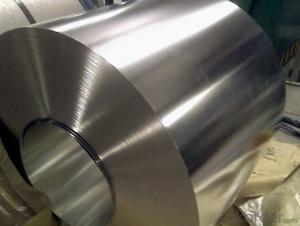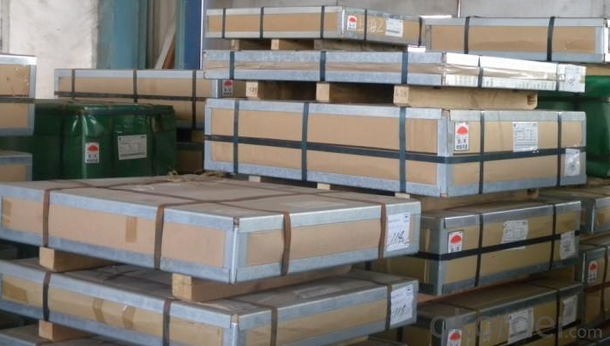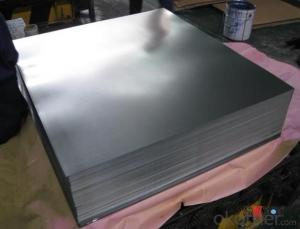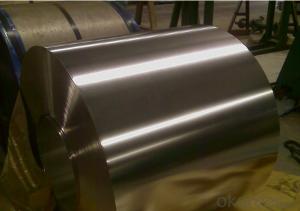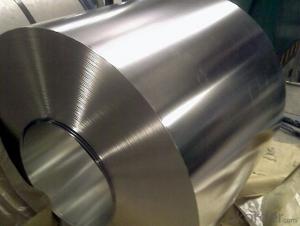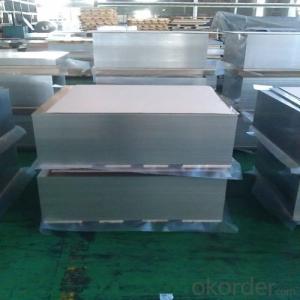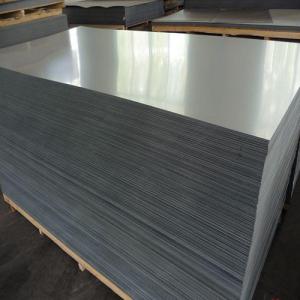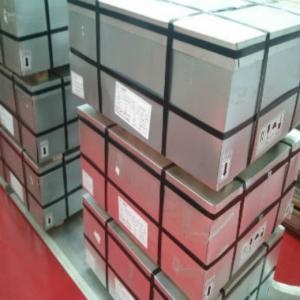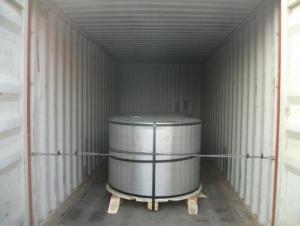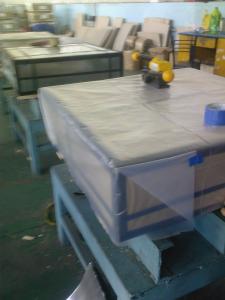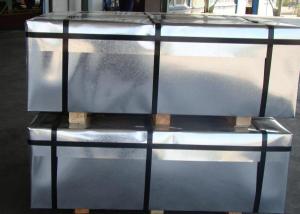Electrolytic Tinplate (ETP) Coil and Sheets for Chemical Packaging
- Loading Port:
- Tianjin
- Payment Terms:
- TT OR LC
- Min Order Qty:
- 25 m.t.
- Supply Capability:
- 7000 m.t./month
OKorder Service Pledge
OKorder Financial Service
You Might Also Like
1.Electrolytic Tinplate (ETP) Coil and Sheets for Chemical Packaging Description
Electrolytic Tin Plate Coils and Sheets for Foods Metal Packaging, is one thin steel sheet with a coating of tin applied by electrolytic deposition. Tinplate made by this process is essentially a sandwich in which the central core is strip steel. This core is cleaned in a pickling solution and then fed through tanks containing electrolyte, where tin is deposited on both sides. As the strip passes between high-frequency electric induction coils, it is heated so that the tin coating melts and flows to form a lustrous coat.
2.Main Features of the Electrolytic Tinplate (ETP) Coil and Sheets for Chemical Packaging
Appearance – Electrolytic Tin Plate is characterized by its beautiful metallic luster. Products with various kinds of surface roughness are produced by selecting the surface finish of the substrate steel sheet.
Paintability and printability – Electrolytic Tin Plates have excellent paintability and printability. Printing is beautifully finished using various lacquers and inks.
Formability and strength – Electrolytic Tin Plates have got very good formability and strength. By selecting a proper temper grade, appropriate formability is obtained for different applications as well as the required strength after forming.
Corrosion resistance – Tinplate has got good corrosion resistance. By selecting a proper coating weight, appropriate corrosion resistance is obtained against container contents. Coated items should meet 24 hour 5 % salt spray requirement.
Solderability and weldability – Electrolytic Tin Plates can be joined both by soldering or welding. These properties of tinplate are used for making various types of cans.
Hygienic – Tin coating provides good and non toxic barrier properties to protect food products from impurities, bacteria, moisture, light and odours.
Safe – Tinplate being low weight and high strength makes food cans easy to ship and transport.
Eco friendly – Tinplate offers 100 % recyclability.
Tin is not good for low temperature applications since it changes structure and loses adhesion when exposed to temperatures below – 40 deg C.
3.Electrolytic Tinplate (ETP) Coil and Sheets for Chemical Packaging Images

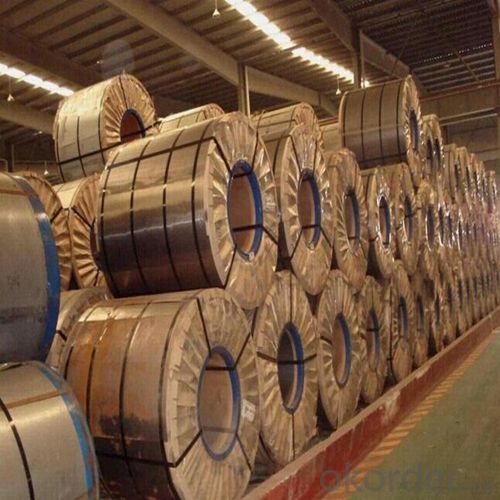
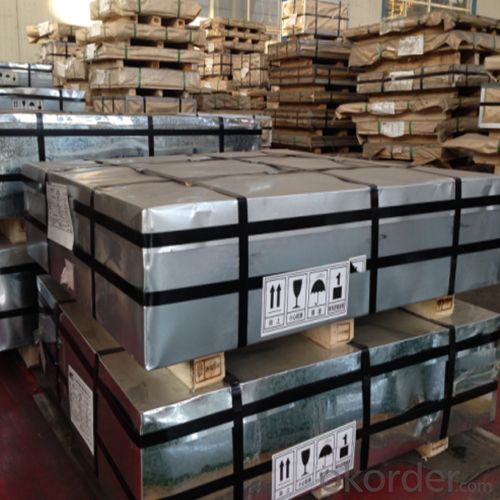
4.Electrolytic Tinplate (ETP) Coil and Sheets for Chemical Packaging Specification
Standard | ISO 11949 -1995, GB/T2520-2000,JIS G3303,ASTM A623, BS EN 10202
|
Material | MR,SPCC |
Thickness | 0.15mm - 0.50mm |
Width | 600mm -1150mm |
Temper | T1-T5 |
Annealing | BA & CA |
Coil Inner Diameter | 508mm |
Weight | 6-10 tons/coil 1~1.7 tons/sheets bundle |
Passivation | 311 |
Oil | DOS |
Surface | Finish,bright,stone,matte,silver |
5.FAQ of Electrolytic Tinplate (ETP) Coil and Sheets for Chemical Packaging
- How are the Electrolytic Tin Plates specified?
The Electrolytic Tin Plates are specified as per the steel base, extent of tempering, the coating weight, annealing method and the surface finish.
- How many types there are for base steels?
The base steels are of three types: Type MR, L, D
-How to place .an order or contact you ?
Please send us Email. we will give you a quick response in seconds .
- How is your quality ?
All our quality is prime even the secondary quality . We have many years experience
In this field with serious quality control standard . Advanced equipment, We welcome your visit to our factory .
- Q: What are the main applications of tinplate in the telecommunications industry?
- Tinplate has several main applications in the telecommunications industry, including the production of high-frequency cables and connectors, as well as the shielding of electronic components. Due to its excellent conductivity and corrosion resistance, tinplate is widely used in telecommunications infrastructure to ensure reliable signal transmission and protect sensitive equipment from electromagnetic interference.
- Q: What are the main applications of tinplate in the agricultural industry?
- Tinplate is commonly used in the agricultural industry for its various applications such as packaging and storage of agricultural products, manufacturing of containers for fertilizers and pesticides, as well as for agricultural machinery components due to its corrosion-resistant properties.
- Q: How does tinplate contribute to the circular economy?
- Tinplate contributes to the circular economy by being highly recyclable and reusable. It can be easily collected, sorted, and processed into new tinplate products, reducing the need for virgin materials. This closed-loop recycling system reduces waste, conserves resources, and minimizes the environmental impact of tinplate production and consumption. Additionally, tinplate's durable and protective properties prolong the lifespan of packaged goods, further contributing to a more sustainable and circular economy.
- Q: What are the common sizes of tinplate sheets?
- The common sizes of tinplate sheets typically range from 0.15mm to 0.5mm in thickness, and can vary in width from 600mm to 1200mm.
- Q: Soup with tin cans loaded also need high temperature sterilization?
- At present, there are DN400x500, DN600x1000, DN800*1000, DN900*1000 and DN900x1500 in the market, and the small sterilization pot with boilers is heated by steam. If not, heating by electricity can also be done. The phone won't be left. If you need any service from the manufacturer, you can call me from Hi. The key is not to sell, eliminating confusion is the key.
- Q: What are the different methods of reusing tinplate packaging?
- There are several methods of reusing tinplate packaging including repurposing them for storage purposes, using them as planters for indoor or outdoor plants, incorporating them into DIY craft projects, or donating them to charitable organizations that can find alternative uses for them.
- Q: How does tinplate contribute to the convenience of pet care products?
- Tinplate contributes to the convenience of pet care products by providing a durable and lightweight packaging option that helps preserve the quality and freshness of the products. It is also easily recyclable, ensuring sustainability while offering a convenient solution for pet owners.
- Q: Can tinplate be used for confectionery packaging?
- Yes, tinplate can be used for confectionery packaging. Tinplate is a type of steel coated with a thin layer of tin, making it a durable and food-safe material. It provides excellent protection against moisture, light, and oxygen, which are important for maintaining the freshness and quality of confectionery products. Additionally, tinplate can be easily shaped and decorated, allowing for attractive and customized packaging designs.
- Q: How has tinplate evolved over the years?
- Tinplate has evolved significantly over the years, primarily due to advancements in technology and manufacturing processes. Originally, tinplate was made by coating iron or steel with a thin layer of tin to prevent corrosion. However, the process has evolved to include various coatings, such as organic, chrome, and polymer coatings, that offer improved protection and durability. Additionally, the production techniques have become more efficient, allowing for higher quality and faster manufacturing of tinplate products. Moreover, the application of tinplate has expanded beyond traditional uses in packaging to include automotive, construction, and electrical industries, further driving its evolution.
- Q: What are the main challenges in the recycling of tinplate?
- One of the main challenges in the recycling of tinplate is the separation of tin from the steel. Tin is a valuable material and it is important to recover as much of it as possible during the recycling process. However, separating tin from steel can be a complex and energy-intensive process. Additionally, contaminants such as paints, coatings, and other metals need to be removed before the tinplate can be recycled, which adds to the difficulty of the recycling process. Another challenge is the collection and sorting of tinplate waste, as it often ends up mixed with other materials in municipal waste streams. This makes it necessary to implement effective collection and sorting systems to ensure that tinplate is properly recycled.
Send your message to us
Electrolytic Tinplate (ETP) Coil and Sheets for Chemical Packaging
- Loading Port:
- Tianjin
- Payment Terms:
- TT OR LC
- Min Order Qty:
- 25 m.t.
- Supply Capability:
- 7000 m.t./month
OKorder Service Pledge
OKorder Financial Service
Similar products
Hot products
Hot Searches
Related keywords
